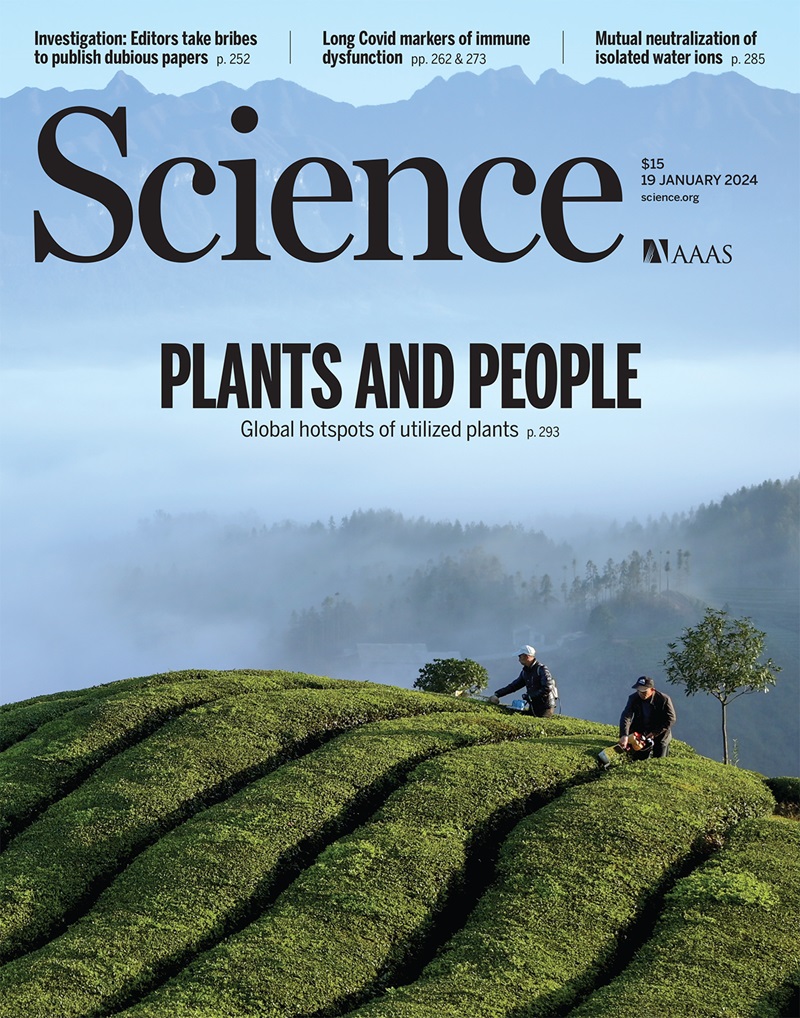Super-dry reforming of methane intensifies CO2 utilization via Le Chatelier’s principle
IF 44.7
1区 综合性期刊
Q1 MULTIDISCIPLINARY SCIENCES
引用次数: 304
Abstract
Upgrading CO2 with methane The use of carbon dioxide as a reactant could help to mitigate its impact on climate, but it is difficult to activate as an oxidant. Buelens et al. combined methane in a high-temperature “super-dry” reforming process that generates reactive carbon monoxide. Both molecules were fed into a reactor containing a nickel methane-reforming catalyst, an iron oxide solid oxygen carrier, and calcium oxide as a CO2 sorbent. The adsorbed CO2 was treated with an inert gas purge that shifted the equilibrium, releasing mainly CO. This isothermal process avoids carbon buildup and can be used with biogas methane that contains substantial levels of CO2. Science, this issue p. 449 A two-step isothermal process converts carbon dioxide and methane into carbon monoxide for chemical and fuel production Efficient CO2 transformation from a waste product to a carbon source for chemicals and fuels will require reaction conditions that effect its reduction. We developed a “super-dry” CH4 reforming reaction for enhanced CO production from CH4 and CO2. We used Ni/MgAl2O4 as a CH4-reforming catalyst, Fe2O3/MgAl2O4 as a solid oxygen carrier, and CaO/Al2O3 as a CO2 sorbent. The isothermal coupling of these three different processes resulted in higher CO production as compared with that of conventional dry reforming, by avoiding back reactions with water. The reduction of iron oxide was intensified through CH4 conversion to syngas over Ni and CO2 extraction and storage as CaCO3. CO2 is then used for iron reoxidation and CO production, exploiting equilibrium shifts effected with inert gas sweeping (Le Chatelier’s principle). Super-dry reforming uses up to three CO2 molecules per CH4 and offers a high CO space-time yield of 7.5 millimole CO per second per kilogram of iron at 1023 kelvin.甲烷的超干重整通过勒夏特列原理加强了CO2的利用
利用二氧化碳作为反应物有助于减轻其对气候的影响,但它很难作为氧化剂被激活。Buelens等人在高温“超干”重整过程中结合甲烷,产生反应性一氧化碳。这两种分子都被送入一个反应器,反应器中含有镍甲烷重整催化剂、氧化铁固体氧载体和氧化钙作为二氧化碳吸附剂。吸附的二氧化碳用惰性气体吹扫处理,改变平衡,主要释放CO。这种等温过程避免了碳的积累,可以用于含有大量二氧化碳的沼气。科学,本期第449页两步等温过程将二氧化碳和甲烷转化为用于化学和燃料生产的一氧化碳。有效地将二氧化碳从废物转化为化学和燃料的碳源需要影响其还原的反应条件。我们开发了一种“超干”CH4重整反应,以提高CH4和CO2的CO产量。我们使用Ni/MgAl2O4作为ch4重整催化剂,Fe2O3/MgAl2O4作为固体氧载体,CaO/Al2O3作为CO2吸附剂。由于避免了与水的反反应,这三种不同过程的等温耦合导致了与传统干重整相比更高的CO产量。通过将CH4转化为合成气,将Ni和CO2提取并储存为CaCO3,强化了氧化铁的还原作用。然后,利用惰性气体扫扫(勒夏特列原理)影响的平衡变化,将二氧化碳用于铁再氧化和CO生产。超干重整每CH4消耗3个CO2分子,在1023开尔文的温度下,每千克铁的CO时空产率高达每秒7.5毫摩尔。
本文章由计算机程序翻译,如有差异,请以英文原文为准。
求助全文
约1分钟内获得全文
求助全文
来源期刊

Science
综合性期刊-综合性期刊
CiteScore
61.10
自引率
0.90%
发文量
0
审稿时长
2.1 months
期刊介绍:
Science is a leading outlet for scientific news, commentary, and cutting-edge research. Through its print and online incarnations, Science reaches an estimated worldwide readership of more than one million. Science’s authorship is global too, and its articles consistently rank among the world's most cited research.
Science serves as a forum for discussion of important issues related to the advancement of science by publishing material on which a consensus has been reached as well as including the presentation of minority or conflicting points of view. Accordingly, all articles published in Science—including editorials, news and comment, and book reviews—are signed and reflect the individual views of the authors and not official points of view adopted by AAAS or the institutions with which the authors are affiliated.
Science seeks to publish those papers that are most influential in their fields or across fields and that will significantly advance scientific understanding. Selected papers should present novel and broadly important data, syntheses, or concepts. They should merit recognition by the wider scientific community and general public provided by publication in Science, beyond that provided by specialty journals. Science welcomes submissions from all fields of science and from any source. The editors are committed to the prompt evaluation and publication of submitted papers while upholding high standards that support reproducibility of published research. Science is published weekly; selected papers are published online ahead of print.
 求助内容:
求助内容: 应助结果提醒方式:
应助结果提醒方式:


